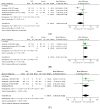A Systematic Review and Meta-Analysis of the In Vivo Haemodynamic Effects of Δ⁸-Tetrahydrocannabinol
- PMID: 29385080
- PMCID: PMC5874709
- DOI: 10.3390/ph11010013
A Systematic Review and Meta-Analysis of the In Vivo Haemodynamic Effects of Δ⁸-Tetrahydrocannabinol
Abstract
∆⁸-Tetrahydrocannabinol (THC) has complex effects on the cardiovascular system. We aimed to systematically review studies of THC and haemodynamic alterations. PubMed, Medline, and EMBASE were searched for relevant studies. Changes in blood pressure (BP), heart rate (HR), and blood flow (BF) were analysed using the Cochrane Review Manager Software. Thirty-one studies met the eligibility criteria. Fourteen publications assessed BP (number, n = 541), 22 HR (n = 567), and 3 BF (n = 45). Acute THC dosing reduced BP and HR in anaesthetised animals (BP, mean difference (MD) -19.7 mmHg, p < 0.00001; HR, MD -53.49 bpm, p < 0.00001), conscious animals (BP, MD -12.3 mmHg, p = 0.0007; HR, MD -30.05 bpm, p < 0.00001), and animal models of stress or hypertension (BP, MD -61.37 mmHg, p = 0.03) and increased cerebral BF in murine stroke models (MD 32.35%, p < 0.00001). Chronic dosing increased BF in large arteries in anaesthetised animals (MD 21.95 mL/min, p = 0.05) and reduced BP in models of stress or hypertension (MD -22.09 mmHg, p < 0.00001). In humans, acute administration increased HR (MD 8.16 bpm, p < 0.00001). THC acts differently according to species and experimental conditions, causing bradycardia, hypotension and increased BF in animals; and causing increased HR in humans. Data is limited, and further studies assessing THC-induced haemodynamic changes in humans should be considered.
Keywords: THC; blood flow; blood pressure; cardiovascular system; heart rate; ∆9-Tetrahydrocannabinol.
Conflict of interest statement
The authors declare no conflict of interest.
Figures











Similar articles
-
A Systematic Review and Meta-Analysis of the Haemodynamic Effects of Cannabidiol.Front Pharmacol. 2017 Feb 24;8:81. doi: 10.3389/fphar.2017.00081. eCollection 2017. Front Pharmacol. 2017. PMID: 28286481 Free PMC article.
-
The cardiovascular and autonomic effects of repeated administration of delta-9-tetrahydrocannabinol to rhesus monkeys.J Pharmacol Exp Ther. 1981 Feb;216(2):247-53. J Pharmacol Exp Ther. 1981. PMID: 6257883
-
Therapeutic Efficacy and Safety of Traditional Chinese Medicine Classic Herbal Formula Longdanxiegan Decoction for Hypertension: A Systematic Review and Meta-Analysis.Front Pharmacol. 2018 May 8;9:466. doi: 10.3389/fphar.2018.00466. eCollection 2018. Front Pharmacol. 2018. PMID: 29867474 Free PMC article.
-
Effectiveness of High-Intensity Interval Training Versus Moderate-Intensity Continuous Training in Hypertensive Patients: a Systematic Review and Meta-Analysis.Curr Hypertens Rep. 2020 Mar 3;22(3):26. doi: 10.1007/s11906-020-1030-z. Curr Hypertens Rep. 2020. PMID: 32125550
-
Telehealth for the management of blood pressure in patients with chronic kidney disease: A systematic review.J Telemed Telecare. 2019 Feb;25(2):80-92. doi: 10.1177/1357633X17743276. Epub 2017 Nov 27. J Telemed Telecare. 2019. PMID: 29172929
Cited by
-
Balancing risks and benefits of cannabis use: umbrella review of meta-analyses of randomised controlled trials and observational studies.BMJ. 2023 Aug 30;382:e072348. doi: 10.1136/bmj-2022-072348. BMJ. 2023. PMID: 37648266 Free PMC article.
-
The Effects of Cannabidiol, a Non-Intoxicating Compound of Cannabis, on the Cardiovascular System in Health and Disease.Int J Mol Sci. 2020 Sep 14;21(18):6740. doi: 10.3390/ijms21186740. Int J Mol Sci. 2020. PMID: 32937917 Free PMC article. Review.
-
Integration of Cannabis Extract Tetrahydrocannabinol:Cannabidiol in an Interdisciplinary Therapy Setting: A Case of Chronic Multilocular Pain Disorder.Med Cannabis Cannabinoids. 2022 Nov 22;5(1):220-225. doi: 10.1159/000527521. eCollection 2022 Jan-Dec. Med Cannabis Cannabinoids. 2022. PMID: 36467780 Free PMC article.
-
Tetrahydrocannabinol Sensing in Complex Biofluid with Portable Raman Spectrometer Using Diatomaceous SERS Substrates.Biosensors (Basel). 2019 Oct 14;9(4):125. doi: 10.3390/bios9040125. Biosensors (Basel). 2019. PMID: 31615082 Free PMC article.
-
Cannabidiol Combination Enhances Photodynamic Therapy Effects on MCF-7 Breast Cancer Cells.Cells. 2024 Jan 18;13(2):187. doi: 10.3390/cells13020187. Cells. 2024. PMID: 38247877 Free PMC article.
References
Publication types
LinkOut - more resources
Full Text Sources
Other Literature Sources
Miscellaneous

